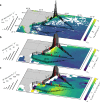Revisiting the distribution of oceanic N2 fixation and estimating diazotrophic contribution to marine production
- PMID: 30783106
- PMCID: PMC6381160
- DOI: 10.1038/s41467-019-08640-0
Revisiting the distribution of oceanic N2 fixation and estimating diazotrophic contribution to marine production
Abstract
Marine N2 fixation supports a significant portion of oceanic primary production by making N2 bioavailable to planktonic communities, in the process influencing atmosphere-ocean carbon fluxes and our global climate. However, the geographical distribution and controlling factors of marine N2 fixation remain elusive largely due to sparse observations. Here we present unprecedented high-resolution underway N2 fixation estimates across over 6000 kilometers of the western North Atlantic. Unexpectedly, we find increasing N2 fixation rates from the oligotrophic Sargasso Sea to North America coastal waters, driven primarily by cyanobacterial diazotrophs. N2 fixation is best correlated to phosphorus availability and chlorophyll-a concentration. Globally, intense N2 fixation activity in the coastal oceans is validated by a meta-analysis of published observations and we estimate the annual coastal N2 fixation flux to be 16.7 Tg N. This study broadens the biogeography of N2 fixation, highlights the interplay of regulating factors, and reveals thriving diazotrophic communities in coastal waters with potential significance to the global nitrogen and carbon cycles.
Conflict of interest statement
The authors declare no competing interests.
Figures




References
-
- Moore C, et al. Processes and patterns of oceanic nutrient limitation. Nat. Geosci. 2013;6:701–710. doi: 10.1038/ngeo1765. - DOI
-
- Falkowski PG. Evolution of the nitrogen cycle and its influence on the biological sequestration of CO2 in the ocean. Nature. 1997;387:272–275. doi: 10.1038/387272a0. - DOI
-
- Karl D, et al. The role of nitrogen fixation in biogeochemical cycling in the subtropical North Pacific Ocean. Nature. 1997;388:533–538. doi: 10.1038/41474. - DOI
-
- Capone, D. G. et al. Nitrogen fixation by Trichodesmium spp.: an important source of new nitrogen to the tropical and subtropical North Atlantic Ocean. Glob. Biogeochem. Cycles19, GB2024 (2005).
Publication types
MeSH terms
Substances
LinkOut - more resources
Full Text Sources
Miscellaneous

